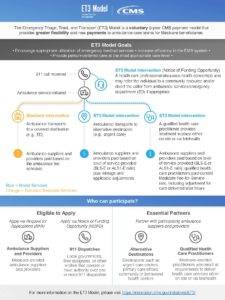
For this entry in the In Depth Series, we will be examining the Center for Medicare and Medicaid Services (CMS) new ET3 reimbursement model.
CMS Announces 184 Participants For ET3 Model, New Funding, which included this except:
CMS has shared the final list of 184 public and private ambulance providers and suppliers selected to participate in the agency’s Emergency Triage, Treat, and Transport (ET3) Model, an alternative payment model that encourages greater care flexibility following a 911 call.
ET3 Model participants span 36 states and include Medicare-enrolled ambulance service suppliers and hospital-owned ambulance providers.
Additionally, the model includes local governments, their designees, or other entities that operate or have authority over one or more 911 dispatches in geographic areas where ambulance suppliers and providers have been selected to participate in the model.
As part of the ET3 Model, CMS also recently issued a Notice of Funding Opportunity worth up to $34 million over two years for local and state governments to expand emergency and non-emergency medical triage services.
The funding will go to governments where model participants are located and will help the model redirect 911 callers with non-emergency conditions to more appropriate alternative sources of care, such as urgent care centers, physician offices, and even food banks and other community resources.
While part of the ET3 Model, the special funding opportunity can help local governments and providers to “identify creative ways to triage the surging number of patients suffering from COVID-19,” CMS stated in the announcement.
The funding will go to up to 40 entities, with funding amounts varying based on the area’s needs and the population it serves.
The federal agency launched the ET3 Model on January 1, 2021, to test whether two new ambulance payments can ensure Medicare beneficiaries receive quality care “at the right place at the right time,” including non-emergency department settings when appropriate.
The new ambulance payments break from traditional Medicare policy, which has only paid for emergency ground ambulance services when beneficiaries are transported to certain types of facilities, including the hospital emergency department, skilled nursing facility, or dialysis center.
This policy has created an incentive for ambulance providers to transport all beneficiaries requiring immediate care to the hospital even if an alternative care site is more appropriate, CMS said.
The program allows EMS providers and healthcare providers to develop new methods for evaluating 911 calls. This may include using telehealth and mHealth tools and platforms to better diagnose patients at the scene, connect virtually with appropriate care providers and transport patients to more appropriate locations, such as primary care office, community health clinic, mental health or substance abuse care provider, stand-alone emergency care clinic or other service.
CMS intends for the ET3 Model to incentivize ambulance providers to consider other—oftentimes cheaper—sites of care, including urgent care clinics and primary care physician offices, as long as the destinations are covered under current Medicare requirements.
CMS describes the program this way:
Emergency Triage, Treat, and Transport (ET3) is a voluntary, five-year payment model that will provide greater flexibility to ambulance care teams to address emergency health care needs of Medicare Fee-for-Service beneficiaries following a 911 call.
Under the ET3 model, the Centers for Medicare & Medicaid Services (CMS) will pay participating ambulance suppliers and providers to
1) transport an individual to a hospital emergency department (ED) or other destination covered under the regulations,
2) transport to an alternative destination (such as a primary care doctor’s office or an urgent care clinic), or
3) provide treatment in place with a qualified health care practitioner, either on the scene or connected using telehealth.
The model will allow beneficiaries to access the most appropriate emergency services at the right time and place. The model will also encourage local governments, their designees, or other entities that operate or have authority over one or more 911 dispatches to promote successful model implementation by establishing a medical triage line for low-acuity 911 calls.
As a result, the ET3 model aims to improve quality and lower costs by reducing avoidable transports to the ED and unnecessary hospitalizations following those transports.

The Center for Medicare and Medicaid Innovation’s (Innovation Center) Emergency Triage, Treat, and Transport (ET3) Model is a voluntary, five-year evaluation of a payment model that will provide greater flexibility to ambulance care teams to address emergency health care needs of Medicare beneficiaries following a 9-1-1 call.

Chief Operating Officer